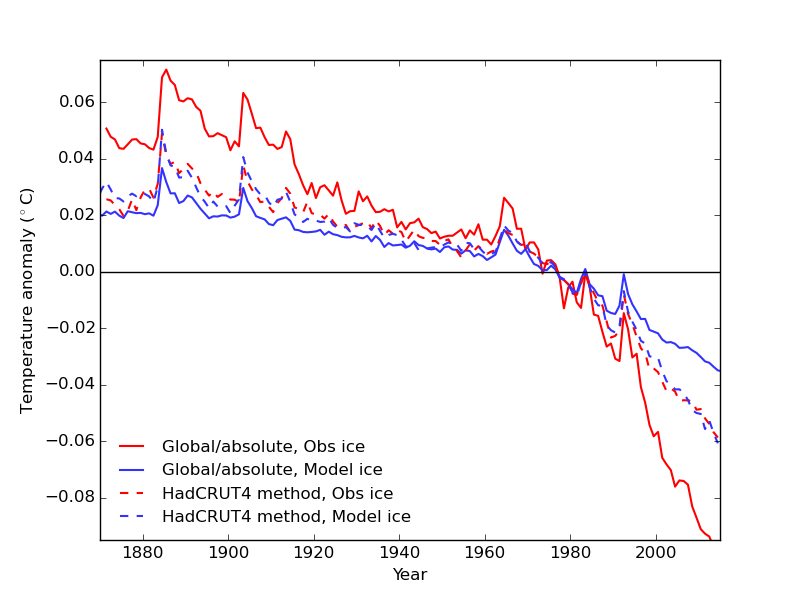Robust comparison of climate models with observations using blended land air and ocean sea surface temperatures
Kevin Cowtan, Zeke Hausfather, Ed Hawkins, Peter Jacobs, Michael E. Mann, Sonya K. Miller, Byron Steinman, Martin B. Stolpe, Robert G. Way
Updates and errata
Updates:
- 2016-03 Santer et al (2000) also calculated blended surface temperatures from models for comparison against observations, predating our work by 15 years.
- 2016-03 Analysis in the CMIP-5 data is complicated by inconsistencies in the deposited files. The inconsistencies we have identified so far are as follows:
- For the 'tos' variable four models (EC-EARTH, MIROC5, MRI-CGCM3, MRI-ESM1) set land cells to a constant rather than missing. For EC-EARTH the cells are set to 273.15 K, for the rest to 0 K.
- For the 'tos' variable most models give a value for 'tos' even under sea ice. One model (CSIRO) marks sea ice cells as missing.
- For the 'sic' variable a number of models set land cells to zero rather than missing.
- The 'sic' and 'sftof' variables for different models may contain values in the range 0...100 or 0...1.
- Some models appear to specify 'sic' as a fraction of the total area of the grid cell rather than as a fraction of the ocean portion of the grid cell.
- For a few models the 'sftof' field does not contain ocean fraction, but rather 1 for cells containing any ocean at all and a missing flag for cells containing no ocean. These files should not be used, as they lead to an overestimation of ocean coverage and a corresponding overestimation in the blending bias.
- 2016-07 A correspondent has asked how our results would be affected by using the observed sea ice cover instead of the sea ice cover from the corresponding model run. The bias in the blended temperature record relative to the surface air temperature record is shown below, for the global blended absolute temperatures, and for the HadCRUT4 method. Sea ice coverage is from HadISST.

Had we used the observed ice coverage instead of the model coverage, our estimate of the bias in the blended absolute temperatures would have been approximately 3 times larger, however the results of the HadCRUT4 method are largely unaffected. The large bias in the blended absolute temperatures arises from the mismatch between the observed sea ice coverage and the model sea surface temperatures, and is in our view spurious. (The observed ice bias is also slightly underestimated due to the issue with the CSIRO 'tos' field noted earlier.)
If the temperature series are averaged by model or model family rather than by run, the blending bias estimate is marginally reduced (~4%). The conclusions of the paper (and Richardson et al 2016) are unaffected.
Errata:
- 2016-03 We have identified an error in the handling of the ocean fields for a few models used in our study, arising from variations in the use of missing values. Correction of this error reduces the size of the bias in the model-observation comparisons by 5-7%. The conclusions of the paper are unchanged. A corrigendum has been published in GRL. A list of the corrections are available in this document: errata-2016-01.pdf.